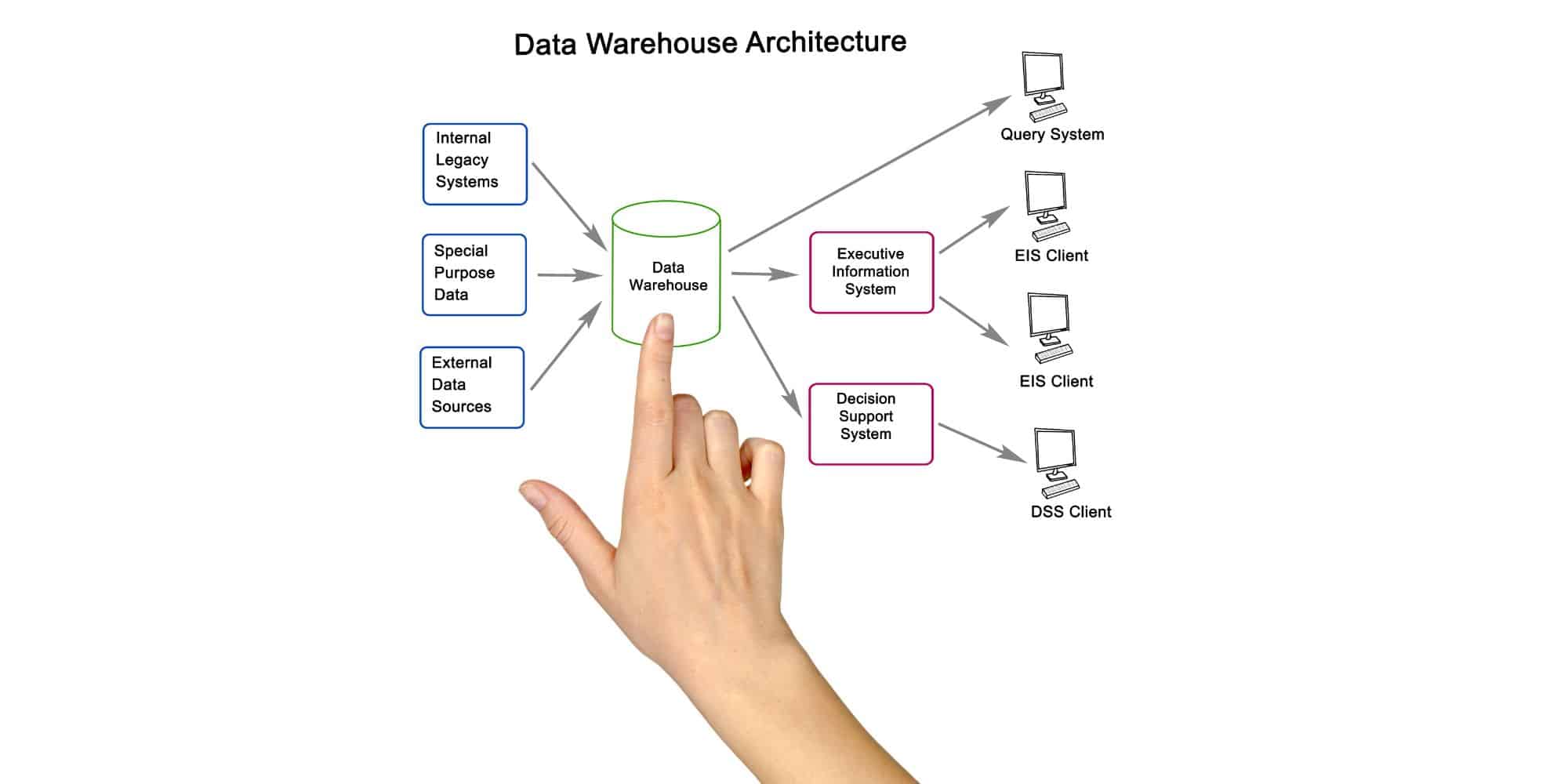Data warehouse architecture is the framework that defines how your organization collects, stores, and organizes data from multiple sources into a single system for analysis and reporting. This structured approach transforms raw data from different business systems into valuable insights that drive better decision making across your company.
A well designed data warehouse architecture combines data from various sources under one unified system, making it easier to handle storage and generate reports efficiently. The architecture includes several key layers that work together, from data extraction and transformation to storage and user access tools. Understanding these components helps you build a system that meets your specific business needs.
Whether you are planning your first data warehousing project or looking to improve an existing system, the right architectural approach can significantly impact your analytics capabilities. Modern solutions offer various design patterns and emerging technologies that can enhance performance while reducing complexity. The choices you make in architecture design will determine how effectively your organization can turn data into actionable business intelligence.
Core Layers and Components of Data Warehouse Architecture
Data warehouse architecture consists of four main layers that work together to transform raw data into useful information for analysis. Each layer handles specific tasks like collecting data from different systems, cleaning and organizing information, storing it safely, and making it available for business users.
Source Layer and Data Ingestion
The source layer connects to all your different data systems and collects information from them. Your data comes from many places like customer databases, sales systems, web applications, and external APIs.
This layer handles both real time processing and batch processing. Real time processing moves data as it happens, while batch processing collects data at set times like every hour or day.
Common data sources include:
- Relational databases (MySQL, PostgreSQL)
- Cloud applications (Salesforce, HubSpot)
- Web APIs and services
- File systems (CSV, JSON, XML)
- Streaming data from sensors or apps
Data ingestion tools extract this information and prepare it for the next step. The data warehouse architecture includes multiple components that work together to manage this process.
Staging Layer and Data Integration
The staging layer is where your raw data gets cleaned and prepared before going into storage. This layer runs ETL processes that extract, transform, and load your data.
Data integration happens here through several steps. First, the system removes duplicate records and fixes errors in the data. Then it changes data formats so everything matches the same standards.
Data cleansing removes incorrect or incomplete information. The system also combines data from different sources that refer to the same things, like matching customer records across multiple systems.
Key staging activities:
- Removing duplicate records
- Fixing data format problems
- Combining related information
- Checking data quality rules
Some systems use ELT instead of ETL. ELT loads raw data first, then transforms it inside the warehouse layer.
Warehouse Layer and Data Storage
The warehouse layer stores your processed data in an organized way that makes analysis fast and easy. This layer uses a database designed for analytical queries rather than daily transactions.
Your data storage can be on premise servers or cloud storage services. Cloud storage offers more flexibility and can grow with your needs. The database stores both current information and historical data going back months or years.
Metadata management tracks information about your data, like where it came from and what it means. This helps users understand what they are analyzing and ensures data quality.
Storage components include:
- Fact tables with business measurements
- Dimension tables with descriptive information
- Indexes for faster query performance
- Partitions to organize large amounts of data
The essential layers of data warehouse architecture work together to provide reliable data storage and fast access.
Presentation Layer and Data Access
The presentation layer gives business users access to warehouse data through reports, dashboards, and analysis tools. This consumption layer connects to business intelligence software and analytics applications.
Users can create reports, build charts, and run queries without knowing technical details about the database. The layer formats data in ways that make sense for business decisions.
Different user groups need different types of access. Executives might use dashboards with key metrics, while analysts need detailed data for complex studies. The system controls who can see what information based on security rules.
Access methods include:
- Business intelligence dashboards
- Self service analytics tools
- Automated report delivery
- Direct database connections for advanced users
This layer also handles query performance by using caches and pre built summaries of common analyses.
Types of Data Warehouse Architecture
Data warehouse architectures range from simple single layer systems to complex multi tier frameworks that separate different functions. Cloud native platforms and modern designs now integrate data lakes and advanced analytics capabilities.
Single-Tier Architecture
Single tier architecture combines all data warehouse components into one unified system. You get direct access to operational data without separate storage layers.
This approach works well for small organizations with limited data volumes. Your users can query data directly from the source systems without complex transformations.
However, single tier systems create performance issues as data grows. Query processing competes with operational workloads for system resources.
Most businesses outgrow this architecture quickly. You will likely need more complex solutions as your data requirements expand.
Two-Tier Architecture
Two tier architecture separates your data warehouse into distinct client and server components. The server layer handles data storage and processing while client applications manage user interfaces.
Your database server stores all warehouse data in a centralized location. Client tools connect directly to query and analyze this information.
This setup reduces network traffic compared to single tier systems. You can also scale server resources independently from client applications.
The main limitation involves processing bottlenecks at the server level. All analytical queries must run through the central database, which can slow performance during peak usage.
Three-Tier Architecture
Three tier data warehouse architectures provide the most comprehensive framework for enterprise data management. You get three distinct layers that handle different functions.
The bottom tier contains your data sources and extraction processes. This includes operational databases, external files, and web services that feed raw information into the warehouse.
The middle tier performs data transformation and storage. Your ETL processes clean and organize information before loading it into dimensional models and fact tables.
The presentation tier handles user access and reporting tools. Business users interact with dashboards, analytics applications, and query interfaces at this level.
This architecture offers excellent scalability and performance isolation. Each tier can be optimized independently without affecting other components.
Modern and Cloud-Native Designs
Modern data warehouse architecture leverages cloud native platforms to handle diverse data types and sources. You can now integrate structured warehouse data with unstructured information from data lakes.
Cloud data warehouse solutions like Snowflake and BigQuery provide elastic scaling capabilities. Your storage and compute resources adjust automatically based on workload demands.
These platforms support both traditional warehouse schemas and data lake storage formats. You can query JSON files, parquet datasets, and relational tables using the same tools.
Serverless architectures eliminate infrastructure management overhead. Your team focuses on data analysis rather than maintaining servers and storage systems.
Cloud native design also enables real time data processing. Streaming analytics and continuous ETL pipelines keep your warehouse updated with fresh information throughout the day.
Design Considerations and Performance Optimization
Effective data warehouse implementation requires strategic planning across data modeling approaches, system scalability measures, quality controls, and security frameworks. These foundational elements determine whether your warehouse can handle growing data volumes while delivering reliable insights to business users.
Data Modeling and Schema Design
Your choice between star schema and snowflake schema impacts query performance and maintenance complexity. Star schema offers simpler queries and faster performance by storing dimension data in denormalized tables around a central fact table.
Snowflake schema reduces storage space through normalization but creates more complex joins. This approach works better when storage costs outweigh query performance needs.
Data marts serve specific business units with focused subsets of warehouse data. You can design them using either schema type depending on user requirements and data complexity.
Designing efficient data warehouse schemas requires balancing query speed against storage efficiency. Consider your users’ typical query patterns when selecting dimensional structures.
Materialized views store pre-calculated results for frequently accessed data combinations. These views eliminate repetitive calculations and speed up complex analytical queries for business intelligence applications.
Scalability and Performance
Performance bottlenecks often occur at data loading, storage, and query execution points. You need to identify these constraints early in your design process to avoid future limitations.
Scalable data warehouse architecture handles increasing data volumes through horizontal and vertical scaling strategies. Plan for growth by selecting technologies that support both approaches.
Partitioning large tables by date, region, or other logical divisions improves query performance. Users access only relevant data partitions instead of scanning entire tables during analysis.
Indexing strategies vary between operational and analytical workloads. Create indexes on frequently queried columns while avoiding over-indexing that slows data loading processes.
Compression techniques reduce storage requirements and improve data transfer speeds. Modern warehouses automatically compress data using algorithms optimized for analytical workloads.
Data Quality and Governance
Data lineage tracking shows how information flows from source systems through transformation processes to final reports. You maintain visibility into data origins and changes throughout the warehouse lifecycle.
Metadata management systems document table structures, column definitions, business rules, and data relationships. This documentation helps users understand available data and supports impact analysis during system changes.
Quality controls include validation rules, consistency checks, and completeness monitoring at each data loading stage. Implement automated testing to catch issues before they affect business intelligence outputs.
Data profiling examines actual content patterns, value distributions, and anomalies in source systems. Use these insights to design appropriate transformation logic and quality measures.
Master data management ensures consistent customer, product, and location information across all warehouse components. Clean master data improves analytical accuracy and user confidence in results.
Role-Based Access and Security
Role-based access control restricts data visibility based on user job functions and organizational hierarchy. You define permissions at table, column, and row levels to protect sensitive information.
Security policies should align with regulatory requirements and business confidentiality needs. Document access rules clearly and review them regularly as organizational structures change.
User authentication integrates with existing corporate directory systems to simplify account management. Single sign-on reduces password complexity while maintaining security standards.
Data masking protects personally identifiable information in development and testing environments. You can provide realistic data for system testing without exposing actual customer details.
Audit logging tracks user activities, data access patterns, and system changes. These logs support compliance reporting and help investigate potential security incidents or data misuse.
Trends and Emerging Solutions in Data Warehouse Architecture
Modern data warehouses are rapidly evolving to incorporate artificial intelligence capabilities, process streaming data in real-time, and leverage powerful cloud platforms. These developments enable organizations to move beyond traditional batch processing toward instant insights and automated decision-making.
Integration with AI and Machine Learning
AI and machine learning are transforming how data warehouses operate and deliver insights. AI-driven data warehousing trends in 2025 focus on automated data processing and intelligent analytics capabilities.
Machine learning algorithms now run directly within your data warehouse environment. This eliminates the need to move data between systems for analysis. You can train models on historical data and apply them to new information as it arrives.
Smart data governance uses AI to automatically classify and tag your data. The system identifies sensitive information and applies appropriate security measures. This reduces manual work for your data engineer team.
Predictive analytics capabilities help you make data driven decisions faster. Machine learning models can spot patterns in your enterprise data warehouse that humans might miss. These insights appear in your reporting tools and BI tools automatically.
Natural language processing allows business users to ask questions in plain English. The AI translates these queries into SQL commands and returns results. This makes data analysis accessible to non-technical team members.
Real-Time Analytics and Streaming Data
Real time analytics capabilities are becoming standard in modern data warehouse solutions. Your organization can now process and analyze data as it flows into your central repository instead of waiting for batch updates.
Streaming data processing handles information from APIs, sensors, and applications continuously. This data flows directly into your data warehouse without temporary storage. You get insights within seconds instead of hours or days.
Event driven architectures trigger actions based on specific data conditions. When certain thresholds are met, your system can automatically update dashboards or send alerts. This helps you respond to business changes immediately.
Your analytics tools can now query both historical and streaming data simultaneously. This combination provides complete context for decision making. Users see current trends alongside historical patterns in the same report.
Integration with unstructured data sources expands your analytical capabilities. Text, images, and sensor data combine with traditional structured information. This eliminates data silos that previously limited your analysis scope.
Cloud Platforms and Analytics Tools
Cloud based data warehouse architectures offer unprecedented scalability and flexibility. Major platforms like Amazon Redshift, Google BigQuery, and Databricks provide enterprise grade capabilities without infrastructure management overhead.
Amazon Redshift integrates seamlessly with other AWS services and Azure Blob storage options. You can scale compute and storage independently based on your workload requirements. The platform handles maintenance and security updates automatically.
Google BigQuery excels at handling massive datasets with its serverless architecture. You pay only for the queries you run and storage you use. The platform connects directly to your existing analytics tools and reporting tools.
Databricks combines data warehousing with advanced analytics capabilities. The unified platform supports both SQL queries and machine learning workloads. Your data engineers can build complex pipelines without managing separate systems.
These cloud platforms eliminate traditional data warehouse limitations around storage capacity and processing power. You can store petabytes of data and run complex OLAP operations without performance degradation. Multi cloud strategies let you choose the best tools for specific use cases while maintaining data consistency across platforms.
Need Help with Data Warehouse Architecture?
Atiba has the specialists you need when it comes to data warehouse architecture. If you have any questions or need help with your data warehouse needs, reach out and a data warehousing expert will reach out as soon as possible.








